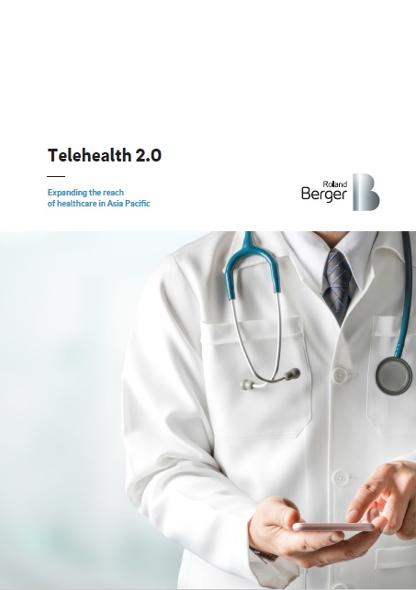Telehealth 2.0
![{[downloads[language].preview]}](https://www.rolandberger.com/publications/publication_image/Telehealth_Updated_Cover-image_download_preview.jpg)
Opportunities, challenges and recommended operating models for Telehealth to succeed in Asia Pacific.


By Yoshihiro Suwa and Aditya Agarwal
Telemedicine was originally intended as a method to treat patients in remote locations, who were situated far away from healthcare facilities or professionals. While it is still used today to address such problems, it has become a tool for convenience. Patients today turn to telehealth for immediate treatment to avoid the hassle of travelling down to the clinics and spending time in the waiting room.

Commercial payors support telehealth due to potential lower costs from lower drug mark-ups and lower expenses incurred, especially for patients located in rural areas, due to episodes of care whereby virtual appointments can replace physical appointments. Providers also appreciate the higher efficiency resulting from quicker diagnosis and treatments arising out of telemedicine.
The Covid-19 pandemic also sped up the adoption of telehealth since physical consultations were restricted and this helped reduce the risk of infection.
Roland Berger explores today's telehealth systems' challenges and opportunities using Orthopedics as a focal example.
"Given how much the Covid-19 pandemic has fast-tracked the healthcare industry's digital transformation, stakeholders must work together on a digital investment strategy to marry medicine and technology well to provide value for the society."
The study raised three challenges and limitations of today's telehealth systems.
Operating solely on an episode-based model amplifies that telehealth is not a one size fits all solution. The telehealth models are currently built for acute episodic care and may not be effective on patients that require constant reviews and chronic care, such as ageing societies.
Teleconsultations are also not able to deliver the best results without physical examinations and updated images. In almost 20% of the Orthopedic cases, physicians had expressed a need for physical examination follow-ups to assess several motor testings more accurately. A lack of centralized access to imaging repositories also delayed accessibility to patients' records.
More efforts need to be invested in infrastructure development for telehealth systems in Asia Pacific. Various markets are underserved and suffering from a shortage of diagnostic facilities such as the DEXA scan machines, which help detect bone disorders. It is also crucial to obtain the buy-in of telemedicine from sceptical key decision-makers and renowned doctors, as they can influence patients to adopt telemedicine. Addressing and resolving the risks such as the potential loss of data or incorrect data input may help to change their mindsets.
In order to advance telemedicine from a service to an ecosystem enabler, the roles of the healthcare stakeholders and system would need to evolve and keep up with today's challenges.
The recommended course of action for the stakeholders should be transiting towards supporting the digital transformation of the healthcare system.
Six telemedicine business model archetypes were also identified in Southeast Asia:
The Orchestrator model stood out as the best way forward for Southeast Asia. The Orchestrator model coordinates more complex interactions and transactions between patients, providers, payors and other healthcare stakeholders in an integrated and seamless manner. The key objective of this model is to ensure affordable healthcare for the community by keeping patients within the network and removing redundancies.
Given how much the Covid-19 pandemic has fast-tracked the healthcare industry's digital transformation, stakeholders must work together on a digital investment strategy to marry medicine and technology well to provide value for the society.

![{[downloads[language].preview]}](https://www.rolandberger.com/publications/publication_image/Telehealth_Updated_Cover-image_download_preview.jpg)
Opportunities, challenges and recommended operating models for Telehealth to succeed in Asia Pacific.